Introduction:-
Comman Eye Conditions : Causes, Symptoms, and Treatment Options

Our eyes are a window to the world, allowing us to perceive its beauty and wonder. However, like any intricate mechanism, they are susceptible to various conditions that can affect our vision and eye health. This comprehensive guide will explore major eye conditions, their causes, symptoms, and the range of treatment options available to safeguard your sight.
Comman Eye Conditions : Causes, Symptoms, and Treatment Options
| S.NO | CAUSES | DEFINITIONS | SYMPTOMS | TREATMENT OPTION |
| 1. | Cataracts Causes | Cataracts are a common eye condition that primarily affects older individuals. They occur when the lens of the eye becomes cloudy, impairing vision. The most common cause of cataracts is age-related changes in the eye’s proteins. | 1.Blurred or cloudy vision 2.Sensitivity to light 3.Difficulty seeing at night Seeing “halos” around lights | Controlling blood sugar levels and regular eye examinations are essential. In advanced cases, laser therapy or surgery may be necessary. |
| 2. | Glaucoma Causes | Glaucoma is a group of eye conditions characterized by increased pressure within the eye, which can damage the optic nerve. The exact cause of glaucoma is not always clear, but it often results from poor fluid drainage. | 1.Gradual loss of peripheral vision 2.Tunnel vision in advanced stages 3.Elevated eye pressure 4.Eye pain and redness | Treatment for glaucoma typically involves medication, laser therapy, or surgery to reduce intraocular pressure and prevent further damage to the optic nerve. |
| 3. | Age-related Macular Degeneration (AMD): Causes: | AMD is a progressive eye condition that affects the macula, the central part of the retina. It often occurs as a result of aging and genetic factors. | 1.Blurred or distorted central vision 2.Difficulty recognizing faces or reading 3.Dark spots or blind spots in vision | While there is no cure for AMD, treatments such as anti-VEGF injections and laser therapy can slow its progression and preserve the remaining vision. |
| 4. | Diabetic Retinopathy Causes: | Diabetic retinopathy is a complication of diabetes that damages blood vessels in the retina. High blood sugar levels contribute to its development. | 1.Blurred or fluctuating vision 2.Dark or empty areas in vision 3.Difficulty with color perception 4.Vision loss in advanced stages | Controlling blood sugar levels and regular eye examinations are essential. In advanced cases, laser therapy or surgery may be necessary. |
| 5. | Dry Eye Syndrome: Causes: | Dry eye syndrome occurs when the eye does not produce enough tears or the tears evaporate too quickly. Causes include age, hormonal changes, medications, and environmental factors. | 1.Dryness, itching, and burning sensations 2.Sensitivity to light 3.Blurred vision Eye fatigue | Artificial tears, lifestyle changes, and in some cases, prescription medications or procedures can alleviate dry eye symptoms. |
| 6. | Conjunctivitis (Pink Eye) | Conjunctivitis, commonly known as pink eye, is often caused by viral or bacterial infections. Allergies and irritants can also lead to this condition. | 1.Redness of the eye 2.Watery or thick discharge 3.Itchy or burning sensation 4.Swelling of the eyelids | Treatment varies depending on the cause. Viral conjunctivitis typically resolves on its own, while bacterial conjunctivitis may require antibiotic eye drops. |
| 7. | Retinal Detachment | Retinal detachment is a medical emergency in which the retina pulls away from the underlying tissue. Causes include trauma, aging, and underlying eye conditions. | 1.Sudden onset of floaters or flashes of light 2.A curtain-like shadow over the field of vision Reduced central vision | Retinal detachment requires immediate surgical intervention to reattach the retina and prevent permanent vision loss. |
| 8. | Crossed Eyes (Strabismus) | Strabismus is a condition where the eyes are misaligned and do not work together properly. It can result from muscle imbalance or neurological issues. | 1.Misalignment of one or both eyes 2.Double vision 3.Eye fatigue and strain | Treatment may involve eyeglasses, vision therapy, or surgery to realign the eye muscles. |
| 9. | Amblyopia (Lazy Eye) | Amblyopia, commonly known as lazy eye, occurs when one eye has weaker vision than the other. It often develops in childhood due to unequal visual input. | Reduced vision in one eye Poor depth perception Squinting or shutting one eye | Early diagnosis and treatment, such as patching the stronger eye or using atropine drops, can help improve vision in the lazy eye |
What precautions should be taken to avoid eye disease?
Taking precautions to avoid eye diseases and maintain good eye health is essential. Here are some tips to help you protect your eyes:

- Regular Eye Exams:
- Schedule regular eye exams with an optometrist or ophthalmologist. These professionals can detect eye problems early and provide appropriate treatment.
- Maintain a Healthy Diet:
- Eat a balanced diet rich in fruits and vegetables, especially those high in antioxidants like vitamin C and E, as they can help protect your eyes from damage.
- Stay Hydrated:
- Drink plenty of water to maintain overall health and eye moisture.
- Protect Your Eyes from UV Rays:
- Wear sunglasses that provide 100% UV protection when you are outdoors, even on cloudy days.
- Use wide-brimmed hats to shade your eyes from the sun.
- Give Your Eyes a Break:
- Follow the 20-20-20 rule when using digital devices: every 20 minutes, look at something 20 feet away for at least 20 seconds to reduce eye strain.
- Ensure proper lighting when reading or working on a computer to minimize glare and eye fatigue.
- Quit Smoking:
- Smoking increases the risk of various eye diseases, including cataracts and macular degeneration. Quitting smoking can significantly benefit your eye health.
- Control Chronic Health Conditions:
- Manage conditions like diabetes, hypertension, and high cholesterol, as they can impact your eye health.
- Follow your doctor’s advice and take prescribed medications as directed.
- Use Safety Eye wear:
- Wear protective eye wear when participating in sports or activities that could lead to eye injury, such as wearing safety goggles when doing home repairs or playing racquet sports.
- Proper Contact Lens Care:
- If you wear contact lenses, follow proper hygiene and care instructions to prevent eye infections.
- Replace lenses as recommended by your eye care provider.
- Avoid Rubbing Your Eyes:
- Refrain from rubbing your eyes, as it can introduce bacteria and irritants, potentially leading to infections or corneal damage.
- Practice Good Hygiene:
- Wash your hands regularly to reduce the risk of transferring germs to your eyes.
- Avoid sharing eye makeup or contact lenses with others.
- Manage Allergies:
- If you have eye allergies, consult an allergist or eye doctor for proper management and treatment.
- Be Aware of Family History:
- Be aware of your family’s history of eye diseases. Some conditions may have a genetic component, and knowing your risk can help you take preventive measures.
- Stay Physically Active:
- Regular physical activity can improve blood circulation, which is beneficial for eye health.
- Restorative Sleep:
- Get enough sleep to allow your eyes to rest and rejuvenate.
Are common eye conditions preventable?
- While not all common eye conditions are preventable, certain lifestyle choices and protective measures can help reduce the risk of developing some conditions. These may include wearing sunglasses to protect against UV radiation, maintaining a healthy diet rich in antioxidants and nutrients beneficial for eye health, avoiding smoking, and practicing good eye hygiene.
Conclusion
In summary, our eyes are invaluable, and their health should never be taken for granted. Understanding the causes, symptoms, and treatment options for major eye conditions is essential for preserving our vision and overall quality of life. Regular eye check-ups, a healthy lifestyle, and timely medical intervention can go a long way in maintaining optimal eye health and ensuring that we continue to see the world’s beauty with clarity and vibrancy. Remember, your eyes are worth the care and attention they deserve.
Frequently Asked Questions (FAQs)
- What are common eye conditions?
- Common eye conditions refer to disorders or diseases affecting the eyes that are frequently encountered in clinical practice. These can include refractive errors, such as myopia (nearsightedness) and hyperopia (farsightedness), as well as conditions like cataracts, glaucoma, and age-related macular degeneration (AMD).
- What causes common eye conditions?
- The causes of common eye conditions vary depending on the specific condition. For example, myopia and hyperopia are primarily caused by abnormalities in the shape of the eye, while cataracts result from the clouding of the eye’s lens. Factors such as genetics, aging, environmental factors, and underlying health conditions can contribute to the development of these conditions.
- What are the symptoms of common eye conditions?
- Symptoms of common eye conditions can include blurry vision, difficulty seeing objects up close or far away, eye pain or discomfort, sensitivity to light, halos around lights, changes in color perception, and vision loss. However, symptoms can vary depending on the particular condition and its severity.
- How are common eye conditions diagnosed?
- Common eye conditions are typically diagnosed through a comprehensive eye examination performed by an eye care professional, such as an optometrist or ophthalmologist. This examination may involve tests to assess visual acuity, eye pressure, eye movement, and the health of the eye’s structures.
- What are the treatment options for common eye conditions?
- Treatment options for common eye conditions depend on the specific condition and its severity. Treatments may include prescription eyeglasses or contact lenses to correct refractive errors, medications to manage conditions like glaucoma, surgical procedures such as cataract removal or laser eye surgery, and lifestyle changes to help manage symptoms and slow disease progression.
References:
- American Academy of Ophthalmology. (n.d.). Eye Health Statistics. Retrieved from https://www.aao.org/newsroom/eye-health-statistics
- Mayo Clinic. (2022). Eye Diseases. Retrieved from https://www.mayoclinic.org/diseases-conditions/eye-diseases/syc-20353371
- National Eye Institute. (2022). Common Eye Disorders. Retrieved from https://www.nei.nih.gov/learn-about-eye-health/eye-conditions-and-diseases/common-eye-disorders







